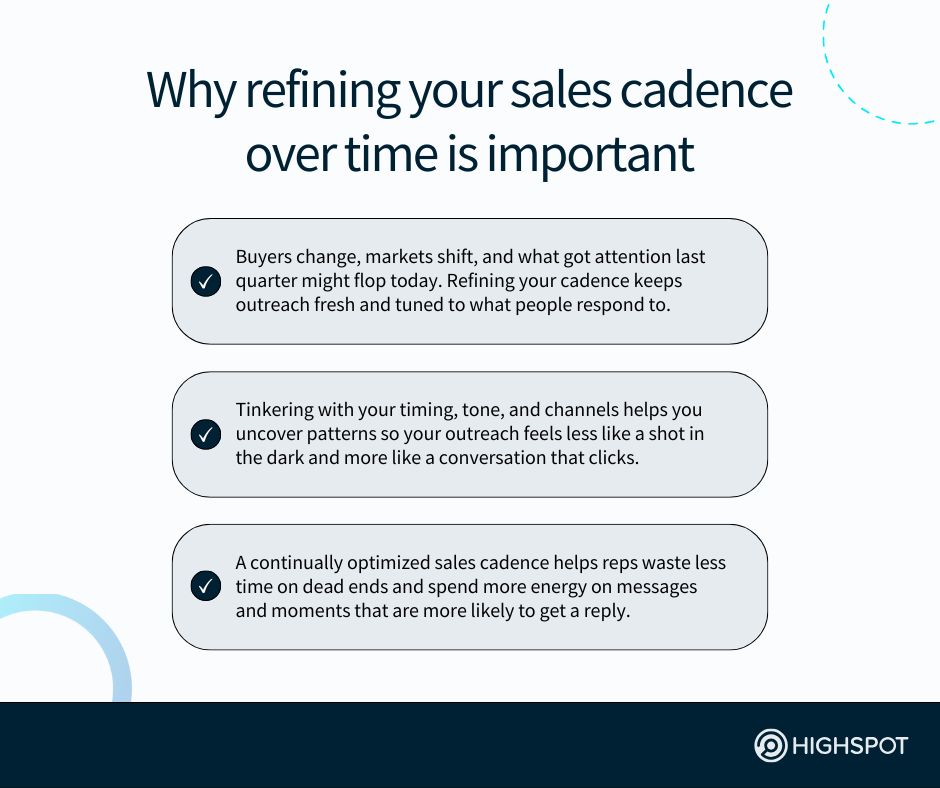Key Takeaways
- A sales cadence is a structured sequence of outreach steps—phone calls, video conferences, emails, and social touches—that reps use to connect with leads. When done well, it helps sellers build momentum and stay top of mind without coming across as pushy or repetitive.
- Tracking outreach performance with real-time engagement analytics helps BDRs test, tweak, and improve their sales cadences, so they’re always learning what resonates and adjusting to stay relevant and effective.
- Go-to-market enablement platforms like Highspot give reps the tools to organise, adapt, and deliver cadences that hit the mark, bringing together content, timing, and insights in one place to help them sell smarter.
Think about a time when you reached out to a vendor or researched a product and never heard from the business in question. You lost interest and moved on.
Now, think about a time when you looked into a solution of some kind and then received a perfectly timed call from a savvy sales rep that picked up right where your research left off. What did you do? Chances are, you reengaged.
That’s what separates top-performing BDRs from the rest today.
The best sellers know how to manage their time, craft personalised and pertinent messaging tailored to each lead, and communicate across different sales channels.
That rhythm is their sales cadence: the backbone of modern prospecting.
Simply put, a strong sales cadence helps reps stay relevant, engage prospects, and move opportunities through the sales pipeline like clockwork. The issue is many sales teams still struggle to find the right balance between persistence and value.

What is a sales cadence?
A sales cadence is a repeatable, strategic sequence of touchpoints—emails, phone calls, and social media messages—that reps use to engage leads and move deals forward. A tailored sales cadence ensures each interaction a rep has with a prospect aligns to where they are in their respective buying journey.
The most effective sales cadences are designed around signals from buyer behaviour, which helps ensure every touch from a seller is timely and relevant. Executed well, a structured cadence drives higher response rates from prospects.
High-performing reps rely on methodical, systematic sales cadences to reengage cold leads, warm up new ones, and, ultimately, maximise their selling time.
| Sales cadence touchpoint | Example of ideal outreach |
|---|---|
| Day 1: Call after web demo request | Open by thanking the prospect for their interest and confirming you saw their WDR come through. Briefly highlight what you’ll cover in a follow-up email to set expectations for engagement. |
| Day 2: Follow-up email after initial call | Recap the value of the solution a lead expressed interest in, based on what you know so far, and include a helpful resource (e.g., one-pager). End with a focused question to encourage a reply. |
| Day 3: Social connection (LinkedIn) | Send a short connection request that references the potential buyer’s role or recent company activity. Keep it professional and low-pressure. Your goal is to simply stay top of mind with them. |
| Day 4: Email with customer proof point | Share a customer success story from a similar company or role to further build your credibility. Keep the message focused on outcomes, and limit the attachment to one strong asset. |
| Day 6: Call with direct question | Ask a clear question about their current processes, workflows, and/or tools, and mention you’ve sent a few helpful resources. Keep it under 30 seconds. Leave a voicemail if there’s no answer. |
| Day 8: Email summarising value | Summarise key takeaways from your previous messages, and offer to conduct a Zoom for a quick catch-up conversation. Keep the tone friendly and confident—no need to repeat earlier content. |
| Day 10: Breakup email with prospect | Let them know this will be your last message for now, unless there’s urgent interest in moving quickly. Thank them for their time, and leave one clear next step if they want to connect later. |
| Day 30: Light re-engagement touchpoint | Circle back with something new: an event invite, an industry update, or a recent product release note. Use this as a chance to re-open the conversation without repeating earlier messages. |
Why is a consistent sales cadence so important for B2B sellers today?
Today’s B2B buyers don’t want to be overwhelmed by reps, but they also don’t want to be forgotten. Reaching them is a balancing act: sending the right message at the right time while anticipating when they want to hear from you.
Prospective customers want you to call, but only when it’s convenient.
Similarly, they want follow-up emails that provide additional information on your organisation’s offerings that interest them, but only if it feels bespoke to their needs.
A 2025 Inc. 5000 survey found that only half 50% of companies offer their salespeople formal sales training. Without a structured sales communication strategy that incorporates training, coaching and cadence frameworks, outreach efforts are inconsistent, unfocused, and ineffective, causing good leads to go cold.
Exactly how many touchpoints should a B2B sales cadence include?
Most inbound sales cadences include 8–12 touchpoints over 10-15 business days (basically, 2-3 weeks) to capitalise on leads’ (seemingly) high buying intent.
Each touchpoint may take on a different format or come through a different channel, such as personalised emails, phone or Zoom calls, or LinkedIn Sales Navigator messages, especially since buyers now engage across an average of 10 channels during their journey, per McKinsey’s B2B Pulse Survey.
The optimal cold outreach cadence, meanwhile, usually includes 6-8 touchpoints across email, phone, and social. You want to mix it up—think a well-timed phone call; a couple of short, punchy emails, and a casual LinkedIn wave.
Spread those touches over two to three weeks so you stay present without being a pest.
This organised, steadfast approach keeps your name in a given prospect’s feed, providing you with multiple opportunities to earn and keep their attention.
High-performing reps often analyse engagement metrics, including open rates, response rates, and call outcomes, to fine-tune their outreach rhythm. Using Highspot, sales teams like yours can see how prospects engage with digital sales rooms and related enablement collateral to get real-time buying signals.
How should reps tailor their sales cadence to their target audience?
Spoiler alert: No two B2B buyers are the same.
Some are relationship-oriented and value human connection. Some are early adopters who prefer strictly digital engagement. And some are fast-moving and switch suppliers quickly if they don’t get what they want from the sales experience.
Success with your prospecting depends on sales and marketing alignment, since your tailored sales cadence needs to mirror your buyer personas, their pain points, shopping behaviours, and communication channels they trust most.
“Focus on solving their business problems and creating the business case and ROI scenarios together with your prospects,” Forbes contributor Julie Thomas recently wrote. “You’ll gain a stronger buy-in and align with their definition of value. Early on, this might mean sharing insights into market trends or success stories from customers with similar challenges.”
This is why you and your GTM team should start by mapping your B2B sales funnel and identifying where potential customers typically stall. Look into whether you are losing inbound leads during initial contact or after a follow-up call.
Then, align the cadence, timing, and content to those friction points.
B2B sales cadence best practices: The proven 10-step structured sequence
That’s the high-level approach.
That’s the high-level approach.
Now, let’s dig deeper into the specific, systematic framework you can use to build a well-structured sales cadence and optimize it over time—based on your industry, business model, and target audience—to move warm and cold leads alike swiftly through your funnel.
1. Send a personalised email to a buyer that highlights your organisation’s unique value
Start strong with a personalised sales message that acknowledges a prospect’s specific pain points and ‘Jobs to Be Done.’ Use their company name in the subject line, and briefly explain your distinct value proposition. For example:
- Subject line: [Company Name] and [Relevant Solution]
- Email copy: Hi [Name], I saw your recent post about improving your [key metric]. I help teams like yours streamline their sales process with [solution]. Would you be available for a short chat to explore how we could help?
Keep it very brief, include a soft call to action (like a short intro call—15 minutes), and focus on relevant solutions to their problems rather than a feature dump.
2. Follow up with a prospective customer quick phone call to reinforce your message
Wait a day or two, then follow up by phone.
Keep your sales script natural by mentioning the email you sent, summarise your value, and ask an open-ended question, such as “How are you currently managing that process today?” Every follow-up call is a chance to gauge interest and collect qualitative feedback you can use in later customer outreach.
3. Leave a short voicemail that piques leads’ curiosity and sets up your next touchpoint
If they don’t respond to your email, leave a personal message on voicemail with your name, company, and one quick benefit statement.
“Hi [Name], this is [Rep] from [Company]. I sent an email about [benefit]. I’ll try you again tomorrow, but you can reach me at [number] if that’s easier.” That’s it. This may incite curiosity and lead them to respond to your initial email.
4. Engage with a lead’s content before you send a formal LinkedIn connection request
Before attempting to connect, though, comment on a prospect’s recent post tied to their business and related challenges. Go beyond “Hi [Name], I really liked the point you made on [topic]. Would love to connect and stay in touch.”
Craft a brief response that actually relays your opinion, not just a generic reply. Specificity and originality make this comment feel personal rather than transactional.
By doing so, you enhance your odds of getting an “Accept invite” click rather than an “I don’t know [your name]” move to the proverbial LinkedIn trash bin.
5. Keep the conversation going on LinkedIn to build rapport with would-be buyers
Now that you’ve engaged on social, follow up with a LinkedIn message referencing content you both follow. Keep it conversational: “I saw we both follow [industry publication]—their recent piece on [trend] got me thinking about how teams handle [pain point]. Curious if you’ve seen similar challenges?”
6. Share a relevant case study or branded asset tailored to their role or industry focus
Send a punch sales follow-up email that shares a useful, recent, and compelling resource that reflects your understanding of their issues.
Think, “Hi [Name], I noticed you mentioned [pain point] in your post. Here’s a case study on how a [peer industry] company solved that same problem using a similar approach.”
7. Make a compelling cold call that focuses on value and doesn’t waste leads’ time
When it’s time for cold outreach again, aim for 20 seconds of relevance: “Hi [Name], this is [Rep]. I noticed you downloaded our [resource]. Can I have 20 seconds to explain how other teams in your space are shortening their sales cycle?”
8. Use a flexible talk track to handle objections, not a static, generic sales script
Don’t rely on a rigid sales script. Instead, use a flexible talk track that gives you room to adjust as the conversation with prospects go in different directions. Ask about leads’ pain points, explore key features they value, and connect back to your value proposition.
Keeping your cadence flexible help you maintain authentic sales engagement.
9. Send a calendar link to allow prospects to schedule a brief intro call at their leisure
After several touchpoints, suggest a short, low-commitment call: “Would you have 10 minutes this week to see if it makes sense to explore further? No pressure—just a quick chat so I can better understand your goals and needs.”
Keep the tone light, and include a calendar link for maximum visibility. A brief, no-pressure chat feels approachable and often converts better than a formal meeting request.
10. If a lead doesn’t engage, send a ‘break-up’ email to let them know you’re available
Your final follow-up should restate your intent and leave the door open: “If now isn’t the right time, I’ll circle back later. If it is, here’s my calendar link. Either way, I appreciate your time.”
They may just not be into you—and that’s okay. This is your final chance to show professionalism and leave a positive impression without being too persistent.
Finding the best sales cadence tools to improve performance
Building an effective sales cadence that is ideal for your sales process requires the right sales tools that are integrated into your broader sales and marketing plan.
The optimal technology for improving sales engagement includes:
- Multi-channel coordination: You’re juggling calls, emails, social touches, and maybe even the occasional carrier pigeon. Great sales cadence tools help keep it all in sync, so you’re not repeating yourself or ghosting a lead by accident. Look for tech that makes it easy to plan, track, and adjust outreach across channels, so your outreach looks smooth, not scattered.
- Personalisation at scale: No one wants to open an email that reads like it was written for “Firstname Lastname.” The best sales cadence solutions let you tailor outreach without writing every word from scratch. Think smart templates, dynamic fields, and timely content that feels 1:1 (even when it’s 1:few or 1:many). Bonus points if you can auto-pull info from CRM or past interactions to make every message feel fresh, relevant, and thoughtfully crafted.
- Real-time analytics: Wondering which emails get opened, calls get callbacks, and touchpoints need a tune-up? Highspot gives you instant insight into what’s connecting and what’s collecting dust. Insights from Nexus™, our AI and analytics engine for GTM teams, can help you tighten your timing, tweak your message, and spend more time where it counts.
- AI-assisted recommendations: Identify which touchpoints, resources, or subject lines perform best and when prospects are most likely to respond. These same AI capabilities can help reps prioritise leads using AI sales prospecting. Teams that blend personalised customer experiences with GenAI are 1.7 times more likely to increase market share than those that do not, according to McKinsey. When sales automation with AI surfaces data recommending next best actions, you can adjust your rhythm instantly, with data to back you up.
- Integrations and coaching insights: Let sales managers use engagement data to identify skill gaps. As Highspot’s Ultimate Guide to Sales Coaching for Revenue Teams explains, “There aren’t enough hours in the day for your managers to give every sales rep the coaching they need—let alone to review hours of meeting recordings to understand where the sales rep needs to improve. They may have access to data from sales conversations, but it can be hard to keep that data organised and collect actual insights.”
Your sales cadence is a learned behaviour, developed through continual practice, internal support from your GTM colleagues, and positive reinforcement from prospects.
When you use data, empathy, and structure to guide your outreach actions, you start having meaningful conversations and follow-ups that turn into opportunities.
Remember: A high-quality sales cadence evolves through measurement, testing, and refinement using key metrics that align actions with outcomes and feedback. Done right, you reengage dormant leads and close more deals that started with a simple, timely follow-up.




